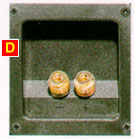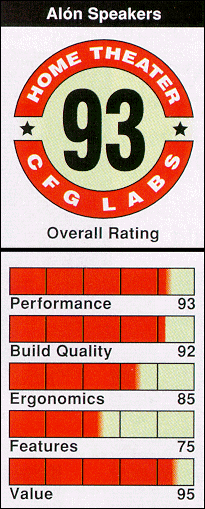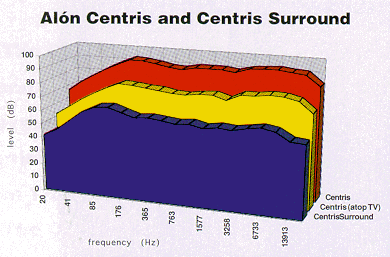
September 1997

Finally, high-end home theater for real people.
by Anthony Chiarella

A. The Centris Surrounds
did a great job reproducing the Harrier-jet effects from True
Lies. |



A. The Centris Surrounds
did a great job reproducing the Harrier-jet effects from True
Lies. |
Carl Marchisotto might not be a household name, but he's something of a legend in the audio community. After spending 15 years as Dahlquist's chief designer and vice president of engineering, this Brooklyn native left to start Alón in 1991. His first system- the groundbreaking Model IV- remains in production to this day and is still considered an excellent loudspeaker. The company's comprehensive lineup begins with the $995/pair Petite minimonitors and culminates with the gargantuan Phalanx, which retails for a cool 22 grand. Despite obvious differences in size and price, all of these designs share one critical characteristic: They're each regarded as a standout product in their class. With the new Centris system, Marchisotto is putting his reputation on the line-can this tradition of excellence survive the cutthroat world of home theater?
The five-piece Centris ensemble includes two different models: the bookshelf-sized Centris LCR (left, center, right) for the front three channels, and the wall-mountable Centris Surround for the rear. At $600 per speaker, the complete package costs a reasonable $3,000. True, you'll need to add a subwoofer, but since the system's frequency response is flat to a lowdown 60 Hz (55 Hz for the Surrounds), any decent bass module should blend beautifully- just remember to set the crossover frequency as low as possible. Chosen for its ability to excel in wall-unit and cabinet installations, the LCR's acoustic-suspension enclosure somehow musters a generous 9OdB efficiency rating, while the dual-ported rears manage to squeeze 91 dB from a lone watt. You'd better like black woodgrain vinyl, though, because no other finish is available.
The Centris' cast woofer baskets are home to 5.25-inch diameter, trilaminate paper cones, which employ a series of coatings to both stiffen and dampen the diaphragms. All aluminum-dome tweeters - 1 inch up front, .75 inch 'round back for broader dispersion- are surrounded by velvet antidiffraction rings. LCR drivers also feature dual-magnet motor assemblies encased in steel for no-excuses video shielding. Alón's high-end motif continues inside the enclosures, where every electrical connection has been painstakingly hand-soldered. Crossovers are executed with such choice audiophile goodies as air-core inductors and polypropylene capacitors and, despite the high cost of such a labor-intensive procedure, are hardwired in order to avoid the sonic degradation of printed circuit boards. A single pair of solid metal binding posts graces the backside of each speaker.
Unlike most LCR satellites, whose D'Appolito configuration symmetrically straddles the tweeter with a pair of woofer cones, the Centris' domes are offset from the bass drivers, positioned at the center of one of the baffles' long edges. According to Marchisotto, this arrangement delivers the most open, airy treble possible, and allows the tweeters to be mirror-imaged either inward, close to the screen or outward, depending upon the room and installation. In my application, the tweets virtually brushed the left, right, and lower edges of the expansive image generated by my Vidikron Crystal 2A projector. Twenty-four-inch hardwood stands supported the stereo pair, while the center was placed atop a Velodyne F1200R subwoofer and aimed at the listening position with the help of rubber feet.
 D. Like the other speakers in the system, the Centris Surrounds come with solid metal binding posts. |
Just how good is the Centris system? Sorry, but I honestly can't tell you. Even after weeks of continuous use, these things seem to improve almost daily. What I can tell you is that, when judged by almost any performance parameter you'd care to choose, the Alóns are the best sounding home theater speakers I've heard anywhere near their price.
 Given the sonic priorities of today's audio/video customers, home
theater speakers usually emphasize wide dynamic and frequency range,
but often sacrifice detail resolution and transient speed. Sure, the
Centris system cranks out the decibels and delivers near-perfect tonal
accuracy, but it is precisely in those areas where competitive
products fail that the Alóns truly excel. Let's start with
spatial performance. After a quick tweakfest, the soundstage was
liberated from the boxes and unfolded in a broad panorama behind and
beyond the speakers. Even with sharply localized information, it was
impossible to identify the LCRs as the source of sound, a tribute not
only to the system's imaging ability, but to its transparent tonal
balance. Of course, using identical models for the front three
channels encouraged seamless tracking of lateral pans, while the
addition of the Centris Surrounds extended these smooth soundscapes to
the farthest corners of my listening room. For all their refinement,
the Alóns really know how to party. Between the system's high
efficiency and 200-watt power handling, you'll have no trouble
reaching volumes in excess of 110 dB, a fact I confirmed with the help
of my trusty RadioShack sound pressure meter. I was particularly
impressed with the Surrounds, which reproduced the helicopter and
Harrier jet effects of True Lies with the same output power and
bass depth as the Aerial SR3 and Triad Gold Surround, both of which
cost nearly four times as much. But while any number of speakers get
very loud, only the best are able to do so as quickly as the
Centris.
Given the sonic priorities of today's audio/video customers, home
theater speakers usually emphasize wide dynamic and frequency range,
but often sacrifice detail resolution and transient speed. Sure, the
Centris system cranks out the decibels and delivers near-perfect tonal
accuracy, but it is precisely in those areas where competitive
products fail that the Alóns truly excel. Let's start with
spatial performance. After a quick tweakfest, the soundstage was
liberated from the boxes and unfolded in a broad panorama behind and
beyond the speakers. Even with sharply localized information, it was
impossible to identify the LCRs as the source of sound, a tribute not
only to the system's imaging ability, but to its transparent tonal
balance. Of course, using identical models for the front three
channels encouraged seamless tracking of lateral pans, while the
addition of the Centris Surrounds extended these smooth soundscapes to
the farthest corners of my listening room. For all their refinement,
the Alóns really know how to party. Between the system's high
efficiency and 200-watt power handling, you'll have no trouble
reaching volumes in excess of 110 dB, a fact I confirmed with the help
of my trusty RadioShack sound pressure meter. I was particularly
impressed with the Surrounds, which reproduced the helicopter and
Harrier jet effects of True Lies with the same output power and
bass depth as the Aerial SR3 and Triad Gold Surround, both of which
cost nearly four times as much. But while any number of speakers get
very loud, only the best are able to do so as quickly as the
Centris.
|
Alón Centris Speaker System $3000 Alón Hunters Run, Suite 104 181 Smithtown Blvd., Nesconset, NY 11767 (516) 265-9577 Circle Reader Service No. 513 Dealer Locator Code ALO |
Auditioning with well-recorded classical and acoustic recordings indicated a slight loss of fine harmonic detail and midrange palpability. No, the Centris don't define the state of the art, but you won't be embarrassed to play them for your audiophile friends, either.
All in all, the Alón Centris system offers serious home theater sound for a price that's a relative bargain.
 We measured the Alón Centris both as a main speaker (top) and
as a center speaker (middle), sitting atop a 52-inch rear-projection
TV. We measured the Centris Surround (bottom) against a wall, the way
it will be positioned in actual use. The curves have been scaled to
fit this chart; we measured both speakers at a base level of 90 dB.
We measured the Alón Centris both as a main speaker (top) and
as a center speaker (middle), sitting atop a 52-inch rear-projection
TV. We measured the Centris Surround (bottom) against a wall, the way
it will be positioned in actual use. The curves have been scaled to
fit this chart; we measured both speakers at a base level of 90 dB.The Centris measures very similarly either standing upright as a main speaker, or sitting horizontally atop a TV set. In both cases, the speaker exhibits a slight boost in both the bass and treble - both rise to about 3 dB higher than the average midrange response. The treble starts to roll off around 14 kHz, and plunges about 8 dB by 20 kHz. The Centris Surround has a pronounced bass hump at the port frequency (106 Hz). Its high-frequency response is unusually strong for a non-direct-radiating surround speaker, remaining fairly level from 350 Hz to 10 kHz, and thus should produce a very clear, detailed sound relative to other speakers of its type. These speakers should be used with a decent-quality amp (as opposed to a cheap receiver) because both drop to 4 ohms impedance in the 200-to-300 Hz range. The Centris Surround also drops as low as 3.56 ohms just below 10 kHz. For more measurements on the Alón Centris and Centris Surround, check out the CFG Labs Web site (www.cfglabs.com) or call (818) 595-1570.
|